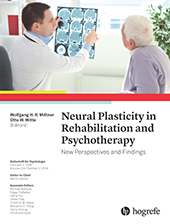Abstract
Abstract. The ability to learn and the ability to reshape brain circuits are regarded as some of the most remarkable and important features of the brain. This ability declines with age due to largely unknown reasons, and it also is altered following stroke. Brain aging is associated with a progressive increase of the levels of inflammatory cytokine in the brain. Likewise, stroke causes pronounced increases of inflammatory cytokines in the brain. Following stroke, plasticity of the cortical representation following sensory deprivation and visualized with [14C]-2-deoxyglucose autoradiography is impaired for several weeks. Likewise, plasticity of visual acuity induced by occlusion of the ipsilateral eye is impaired. Both forms of plasticity may be rescued by treatment with anti-inflammatory drugs. In contrast to this, ocular dominance plasticity which is also induced by visual occlusion is not rescued by this intervention, neither following stroke nor in aged brains. Antiinflammatory interventions may therefore be a useful tool to enhance brain plasticity following stroke, but need to be supplemented by additional strategies to enhance brain plasticity.
References
(2011). Training-induced neural plasticity in golf novices. The Journal of Neuroscience: The Official Journal of the Society for Neuroscience, 31, 12444–12448.
(1997). Copper-zinc superoxide dismutase and isolectin B4 binding are markers for associative and transhemispheric diaschisis induced by focal ischemia in rat cortex. Neuroscience Letters, 228, 163–166.
(2004). Efficacy of rehabilitative experience declines with time after focal ischemic brain injury. The Journal of Neuroscience: The Official Journal of the Society for Neuroscience, 24, 1245–1254.
(2014). Impact of indomethacin on neuroinflammation and hippocampal neurogenesis in aged mice. Neuroscience Letters, 572, 7–12.
(2010). Reducing excessive GABA-mediated tonic inhibition promotes functional recovery after stroke. Nature, 468, 305–309.
(2014). Long-term sequelae of severe sepsis: cognitive impairment and structural brain alterations – an MRI study (LossCog MRI). BMC Neurologoy, 14, 145.
(2011). Global impairment and therapeutic restoration of visual plasticity mechanisms after a localized cortical stroke. Proceedings of the National Academy of Sciences of the United States of America, 108, 15450–15455.
(1998). Increased long-term potentiation in the surround of experimentally induced focal cortical infarction. Annals of Neurology, 44, 255–258.
(2012). Experience-dependent brain plasticity after stroke: effect of ibuprofen and poststroke delay. The European Journal of Neuroscience, 36, 2632–2639.
(2007). Photothrombotic infarct impairs experience-dependent plasticity in neighboring cortex. Neuroreport, 18, 165–169.
(2016). Reduced tonic inhibition after stroke promotes motor performance and epileptic seizures. Scientific Reports, 6, 26173.
(2012). Dysregulated neuronal-microglial cross-talk during aging, stress and inflammation. Experimental Neurology, 233, 40–48.
(2012). Experience-dependent plasticity of thebBarrel cortex in mice observed with 2-DG brain mapping and c-Fos: Effects of MMP-9 KO. Cerebral Cortex, 22, 2160–2170.
(2004). Gene expression profiling in the intact and injured brain following environmental enrichment. Journal of Neuropathology and Experimental Neurology, 63, 598–609.
(2012). Vision and visual plasticity in ageing mice. Restorative Neurology and Neuroscience, 30, 161–178.
(2011). Impairment of experience-dependent cortical plasticity in aged mice. Neurobiology of Aging, 32, 1896–1905.
(2011). Stroke and the immune system: From pathophysiology to new therapeutic strategies. Lancet Neurology, 10, 471–480.
(2005). Motor improvements after focal cortical ischemia in adult rats are mediated by compensatory mechanisms. Behavioural Brain Research, 162, 71–82.
(2010). Altered histone acetylation is associated with age-dependent memory impairment in mice. Science, 328, 753–756.
(2006). Enhancement of vision by monocular deprivation in adult mice. The Journal of Neuroscience: The Official Journal of the Society for Neuroscience, 26, 11554–11561.
(2002). Widespread and long-lasting alterations in GABA(A)-receptor subtypes after focal cortical infarcts in rats: mediation by NMDA-dependent processes. Journal of Cerebral Blood Flow and Metabolism: Oofficial Journal of the International Society of Cerebral Blood Flow and Metabolism, 22, 1463–1475.
(2015). Microglia-dependent alteration of glutamatergic synaptic transmission and plasticity in the hippocampus during peripheral inflammation. The Journal of Neuroscience, 35, 4942–4952.
(2015). Phosphoinositide 3-kinase γ restrains neurotoxic effects of microglia after focal brain Ischemia. Molecular Neurobiology, Advance online publication. doi: 10.1007/s12035-015-9472-z
(2010). Age-related decline of functional inhibition in rat cortex. Neurobiology of Aging, 31, 504–511.
(1994). Local immune responses in the rat cerebral cortex after middle cerebral artery occlusion. Journal of Neuroimmunology, 55, 195–203.
(2011). Attenuated inflammatory response in aged mice brains following stroke. PloS One, 6, e26288.
(2014). Age-specific transcriptional response to stroke. Neurobiology of Aging, 35, 1744–1754.
(2013). Attenuated inflammatory response in triggering receptor expressed on myeloid cells 2 (TREM2) knock-out mice following stroke. PLoS One, 8, e52982.
(2006). Microarray-based long-term detection of genes differentially expressed after cortical spreading depression. The European Journal of Neuroscience, 24, 841–856.
(2000). Functional differentiation of multiple perilesional zones after focal cerebral ischemia. Journal of Cerebral Blood Flow and Metabolism: Official Journal of the International Society of Cerebral Blood Flow and Metabolism, 20, 1149–1165.
(1999). Neuronal dysfunction, epilepsy, and postlesional brain plasticity. Advances in Neurology, 81, 25–36.
(2015). Microglia: Dynamic mediators of synapse development and plasticity. Trends in Immunology, 36, 605–613.



